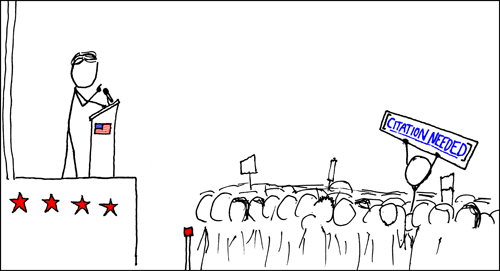
 When you use information (data, images, ideas, quotations, etc.) in your papers, presentations, videos, etc., you need to reference the original source. In other words, provide details about where the information came from:
When you use information (data, images, ideas, quotations, etc.) in your papers, presentations, videos, etc., you need to reference the original source. In other words, provide details about where the information came from:
+ To give credit where it's due.
+ To help your audience find the same sources (which could help their research).
+ To show there is support to back up the ideas you present.
+ To establish your authority and credibility. Citing makes you look smart and trustworthy because you show your audience that you did your research and that got information from reliable sources.
+To avoid plagiarism.
Image courtesy of xkcd
Use the American Chemical Society (ACS) style for your chemistry citations.
Citations Have Two Parts.


Field, S. Culinary Reactions: The Everyday Chemistry of Cooking; Chicago Review Press: Chicago, IL, 2012.
In-Text citation: (Field, 2012)
Company, M.; Karsa, D. R. Vehicle Cleaning. In Handbook for Cleaning/Decontamination of Surfaces; Elsevier, 2007, pp. 439-458. DOI: 10.1016/B978-044451664-0/50013-9.
Parenthetical In-Text Citation: (Company and Karsa, 2007)
Oyedele, A. O.; Gbolade, A. A.; Sosan, M. B.; Adewoyin, F. B.; Soyelu, O. L.; Orafidiya, O. O. Formulation of an Effective Mosquito-Repellent Topical Product from Lemongrass Oil. Phytomedicine 2002, 9 (3), 259–262. https://doi.org/10.1078/0944-7113-00120.
Parenthetical In-Text Citation: (Oyedele et al., 2007)
Mundy, B. A New Simple Process Extracts Valuable Compounds From Seawater. SciTechDaily, December 14, 2022. https://scitechdaily.com/a-new-simple-process-extracts-valuable-compounds-from-seawater (accessed 2020-02-21).
Parenthetical In-Text Citation: (Mundy, 2022)